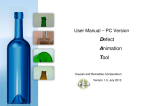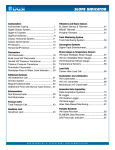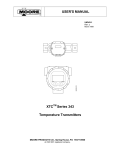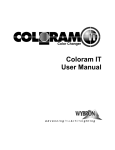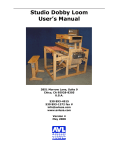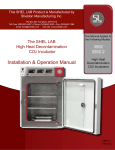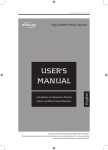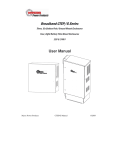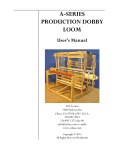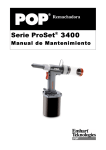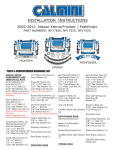Download the DIP-30A Manual - CAL
Transcript
CAL-AV LABS, INC. Tucson, AZ www.cal-av.com USER MANUAL / ASSEMBLY INSTRUCTIONS DIP-30A FULL-SIZE 30 METER ROTATABLE DIPOLE Publication Date: 2000 Oct 15 For Antennas Shipped after 2000 Oct 01 This manual is available at www.cal-av.com (no copy restriction) DESCRIPTION: The DIP-30A is a full-size rotatable dipole for the 30-meter band. It is noticeably quieter than a vertical. And, when mounted at the same feed point height, it exhibits both higher efficiency and more gain (directivity) than an Inverted Vee. It is about 50 feet in length, and weighs 22 pounds, including all mounting hardware and the EB-1 balun. In no-ice conditions, wind survival is 100 MPH. For more details, see Appendices A, B, and C. UNPACKING: Inspect carton for any sign of shipping damage. Then open carton and inspect contents for hidden damage. Shipping damage is not a common occurrence, but it does happen. If damage is found, notify the store, or in the case of direct shipment to you, notify the carrier. Remove contents and inventory for the following: 1. Large bundle of element pieces and mast-to-element mounting plate 2. EB-1 Balun Kit 3. Manual 4. Hardware Kit Page 1 of 1 ASSEMBLY: Tools Required: A. Combination Wrench, 9/16 inch B. Screwdriver, Phillips, #2 C. Nut Driver, 3/8" D. Hand rivet tool, also known as "POP" or "BLIND" rivet tool. These are available from tool and hardware stores. Use the smallest nozzle or hole selection for the 1/8" rivets. E. A rope bridle for lifting the assembled antenna F. A hoisting rope G. One or more "TAG" lines, 3/16" or so, for control of the antenna while hoisting. GENERAL: This antenna has been pre-assembled at the factory and then disassembled for shipment. However, it may be a good idea to check the measurements on the elements during assembly. The important measurements are those of the exposed lengths. That is, from the outer edge of an element component to the outer edge of the next larger one. The centermost element pieces (the ones that include the feed point terminals) are exposed for their entire length. Element exposed lengths can be found in Appendix D, Parts List. Element pieces are swaged (at the last several inches farthest away from the center) down onto the next smaller diameter element piece. Sometimes the amount of size reduction due to the swage is just a few hundredths of an inch, however the swage IS visible. Beginning with the innermost element piece (near the center) and going toward the last element piece (the tip), each element piece fits into the swaged end of the preceding larger diameter piece. Element pieces have been marked for re-assembly with markings on both sides of each joint. Beginning with A1-A1 at the Fiberglas connecting piece, then A2-A2 at the next joint out, then A3-A3, and so on. The other side of the element begins with B1-B1, and is marked in a similar pattern. Page 2 of 2 JOINING PIECES: Except for the feed point joints, which are fastened with 10-24 screws, assemble joints as follows: 1. Clean any dirt, dust, or tape residue from the outer surface of the smaller diameter tubing to be joined. To the extent possible, also clean the inside surface of the larger tube. Tape residue may easily be removed with WD-40 or mineral spirits on a piece of rag or paper towel. Remove any residue of WD-40 or mineral spirits. 2. Use the supplied Scotch-Brite pad to clean the surface of the part of the tube to be mated. This cleaning will produce a uniform, matte finish. 3. Wipe down with Methyl Ethyl Ketone (MEK) (preferred) or Acetone. Either of these is available from most hardware stores in pint cans. Please read and understand the warnings on the container regarding use of these solvents. 4. Apply the supplied silicone grease, working it into the cleaned surface thoroughly. The amount of silicone grease needed is just enough to create a film between the two pieces of metal. The grease serves to prevent galling, to exclude moisture from between the metal pieces at points of contact, and to protect the electrical connection from oxidization. NOTE: Because freshly cleaned aluminum immediately begins to regrow its the joints reason, it one or two protective oxide coating, it is important to assemble within a few minutes of cleaning. For this may be necessary to clean, grease, and fasten just joints at a time. 5. After treatment, assemble the pieces by sliding them together, with a rotary motion if necessary. Be careful not to allow any dirt or grit into the joint. 6. Carefully align the holes. A tapered pin or center punch may be useful for the initial alignment of the holes. Place rivets in all three holes before setting any of them. Then, set them. NOTE: Rivet holes are semi-random drilled. At the factory, the joint was correctly assembled; the first hole was drilled, a rivet installed, then the remaining holes drilled with the joined pieces unable to move relative to each other. Then, the one installed rivet was drilled out. This process results in holes that are as nearly-perfectly aligned as possible. With this process, every joint in the assembly is unique and must be reassembled with only the two original pieces. If the holes do not match perfectly or very nearly so, then something is wrong, and the correct parts must be identified and used. Page 3 of 3 FURTHER NOTE: The elements are joined with closed-end rivets. The innermost few element pieces are joined with rivets that have a grip range appropriate for the combined wall thickness of the tubing involved. The appropriate rivet part number will be marked on the element in red. ELEMENT ASSEMBLY: Prepare sturdy table or bench for antenna assembly. Unwrap outer turns of black tape to release 2 smaller telescoped element pieces. Untape 2 large diameter tubes. Note: tape is best removed by unwinding. This will result in a minimum of tape residue on antenna elements. Tape residue on elements can be removed with mineral spirits or WD-40. With mast clamp at center of table, note method of pre-assembly of element A1 to mast connector and mounting plate. Carefully remove and save screw, nuts and lock-washers from Fiberglas connector piece. Remove nuts and washers on U-bolt for element B1 and remove insulator. Slide insulator over end of element section marked B1. Slide tube end B1 over Fiberglas connector until the holes in the Fiberglas and element are aligned. Legend B1 on Fiberglas and legend B1 on element should be facing in the same direction. Insert screw for B1 connection in same direction as screw for A1 connection. Nuts, lock washers, and washers should be assembled to match pre-assembled parts on A1 connection, with 10-24 nuts closest to fiberglass fully tightened. Place U-bolt saddle between mounting plate and insulator. Assemble U-bolt using flanged nuts and lock washer. Do not tighten U-bolt yet. Loosen U-bolt nuts on A1 connection side and adjust as follows: 2-inch visible section of Fiberglas connector piece between B1 and A1 tubes should be centered on small hole in mounting plate. Adjust grey PVC insulators so that they are centered under U-bolts. Rotate element so that rivets will be at bottom edge when antenna is mounted on a mast. The heads of the 10-24 screws will be in the space between the mounting plate and the element, with the nuts accessible for connecting the balun. Tighten U-bolt nuts by alternating so that approximately an equal amount of U-bolt is visible on each side. Continue to tighten until lock-washer is flat and then 1/2 turn more. This completes assembly of center section of antenna. ready to assemble remaining element pieces. We are now Continue the process of cleaning, applying silicon grease, matching markings and holes, and riveting, until both sides of the element have been assembled. NOTE: If the antenna is to be painted, this is the time to paint the element, along with the mast mounting plates and u-bolts. see Appendix F, "Painting Instructions". Page 4 of 4 FINAL ASSEMBLY: NOTE: The space required for this procedure is about 5 feet wide by 55 feet long. This can be a driveway, rooftop, etc. putting the element on a couple of sturdy tables will make this assembly much easier. Place the element on the element mounting plate and position it with the long dimension of the plate parallel to the element. Lay the element onto the plate so that it is centered on the plate and the PVC insulators are each centered over the holes for the U-bolts. Install the U-bolts over the PVC insulators, through the U-bolt clamps, and through the holes in the plate. The element should be aligned so that when it is in place on the mast, all rivets will be facing down for drainage, and the 10-24 nuts and washers are accessible for connecting the balun. The nuts on the U-bolts should be tightened just enough to pull the insulator snugly into the clamp part of the U-bolt clamp. This is usually enough torque to just flatten the split-ring lock washer, plus half a turn more; this also applies to tightening the U-bolt clamps onto the mast. NOTE: The most popular mast diameter by far is 2.0" O.D. The Ubolts supplied as standard with the DIP-30A is for this size mast. If necessary, an element to mast plate for other common mast sizes can be supplied; contact the factory. After mounting the antenna, connect the BALUN, and secure it to the mast in such a way that is not under stress from the connecting cable. Use silicone grease inside the connecting cable plug-to-BALUN connection to exclude moisture. (See Appendix G, BALUN Installation) Complete painting of the hardware and connections near the mast, if desired. (See Appendix F, Painting Instructions) NOTE: Use an adequate number of people, patience, common sense and great care. These will get your new antenna into the sky without damage to it or you! If you are not yet experienced with installation of antennas, we recommend that you get some experienced help for the first few times. Then you can help newcomers! BE PARTICULARLY CAREFUL WITH REGARD TO WORKING ON TOWERS AND NEAR POWER LINES. Page 5 of 5 APPENDIX A SPECIFICATIONS DIP-30A DESCRIPTION The DIP-30A is a rotatable dipole for the 30-meter amateur band. It is an unloaded, full size element. It is noticeably quieter than a vertical, and when mounted at the same feed point height, exhibits both higher efficiency and more gain than an Inverted Vee. It is constructed of multiple sections of 6061-T6 aluminum tubing. Successively smaller sections are used from the center toward the tips of the element, resulting in a tapered element. A mounting plate and hardware which allow mounting the dipole on a 2" mast are supplied with the antenna. (Mounting plates for mounting the antenna on other sizes of masts are available from the factory.) The mounting plate includes insulators which electrically isolate the split element from the mast mounting plate. A BALUN for coaxial cable feed is supplied with the antenna. The BALUN incorporates a UHF receptacle for connection of the coax's UHF plug (e.g. a PL-259). PHYSICAL SPECIFICATIONS Materials Elements: Aluminum, 6061-T6. Accessories: Aluminum, Steel, and PVC Size Element Diameter: elements taper from 1.875 inches to 0.375 inches Element Length: 50.75 feet Element Sag: 16.7 inches Turn Radius: 25.38 feet Weight: 21.5 pounds, including mounting plates, hardware, and supplied (0.5lb) EB-1 BALUN Projected Area: 4.2 square feet Page 6 of 6 WIND SURVIVAL The antenna is designed to reach the maximum allowable stress for the aluminum material at an actual airspeed across the element in the worst case direction of 106 Miles Per Hour (MPH). We rate the element to survive exposure to an airspeed of 100 MPH. This corresponds to a stress safety factor of 1.12 and does not take ice loading into account. When installed at the recommended 46 foot height above ground, the antenna is rated for operation in a basic wind speed zone of 100 MPH under UBC-97 (exposure) C. ELECTRICAL SPECIFICATIONS Gain: 2.15 dBi, 0 dBd; (this is a full-size dipole) Feed Point Impedance: Approximately 73 Ohms (This applies only at resonance and at recommended height above local earth. Both resonant frequency and the resistive component of the feed point impedance are affected by the height above ground. See VSWR Graph showing theoretical variation in these parameters over frequency for various mounting heights) VSWR BANDWIDTH: 2.0 to 1 or less over 600 KHz The antenna may also be fed with 50-ohm feedline. If it is, then the minimum VSWR when mounted at the recommended height will be 1.5 to 1. NOTE: Please see patterns and graphs for more information NOTE: CAL-AV reserves the right to make and implement design improvements without notice. Specifications updated: 6/06/2000 Page 7 of 7 APPENDIX B DIP-30A PATTERNS AND GRAPHS Page 8 of 8 Page 9 of 9 Page 10 of 10 Page 11 of 11 APPENDIX C DIP-30A MECHANICAL DRAWINGS Under Construction Page 12 of 12 Appendix D DIP-30A - PARTS LIST MOUNTING PLATE ASSY, consisting of: 1 ea. Plate, Element to Mast, 6.75"X6"X0.25", 6061-T6, per drawing #000328-000-0001 REV A.00.0 4 ea. Clamp assy, 2" nominal, stainless ELEMENT ASSY, consisting of: 1 ea. center insulating coupling, Fiberglas, 1.5" dia., 8" long 2 ea. screw, 10-24, 2.5" long, Phillips pan head, stainless 8 ea. washer, flat, AN-960-10, stainless 4 ea. washer, lock, split-ring, #10, stainless 2 ea. insulator, element mounting, 1.75" nominal I.D. 2 ea. tube, 1.875" dia., 0.125 wall, 58" overall,58" exposed 2 ea. tube, 1.50" dia., 0.095 wall, 45" overall, 42" exposed 2 ea. tube, 1.25" dia., 0.083 wall, 62" overall, 59" exposed 2 ea. tube, 1.00" dia., 0.049 wall, 18" overall, 15" exposed 2 ea. tube, 0.875" dia., 0.049 wall, 18" overall, 15" exposed 2 ea. tube, 0.75" dia., 0.049 wall, 21" overall, 18" exposed 2 ea. tube, 0.625" dia., 0.049 wall, 22" overall, 19" exposed 2 ea. tube, 0.50" dia., 0.049 wall, 30" overall, 27" exposed 2 ea. tube, 0.375" dia., 0.035 wall, 58" overall, 55" exposed NOTE: All element tubing material is 6061-T6 12 ea. Rivet, Aluminum, closed end, Emhart AD55H, 5/32" dia. 6 ea. Rivet, Aluminum, closed end, Emhart AD53H, 5/32" dia. 30 ea Rivet, Aluminum, closed end, Emhart AD42H, 1/8" dia. Note: Rivets used to fasten joints A2 / B2 out to A4 / B4, inclusive, are 5/32" diameter. The rivet part number is marked in red on each joint. The remaining joints use AD42H rivets (1/8" diameter). 1 ea. BALUN, Cal-Av Labs Model EB-1, with installation kit. Page 13 of 13 APPENDIX E OPERATIONAL NOTES FEEDPOINT IMPEDANCE This is a function of height above ground. The feed point impedance of a dipole in free space is approximately 73 ohms. As a horizontal dipole is raised from just above the ground, its impedance increases from a very low value, (less than 20 ohms) through the free-space value of 73 ohms at half a wavelength above effective ground, then to a value significantly above 73 ohms, then back through 73 ohms at one wavelength above ground, and so on, oscillating about the 73-ohm value at each half wavelength. The excursions of these oscillations become smaller and smaller as the height becomes remote from the ground. (see Appendix B, Patterns and Graphs) For vertical operation with the lower tip of an element just above ground, say 0.02 wavelength, the feed point impedance is just under 100 ohms. VSWR Because of the characteristic impedance vs. height, the minimum VSWR will vary. At a half wave above effective ground, the antenna will yield a VSWR of 1:1 when fed with a 72-ohm feed system. (e.g. a tuner, followed with RG-11 to the antenna) For most installations, which are 50-ohm systems, the minimum VSWR will be about 1.4:1. This is of no importance unless the feed line is very lossy. For runs of more than 50 feet to the antenna, we recommend a high-quality, large size cable such as LMR-400 or RG-213. TAKE-OFF ANGLE CONTROL, NVIS OPERATION For single lobes broadside to the element, the antenna should be operated one-half wavelength above effective ground. This is probably the best all-purpose height. As the dipole is raised above this height, secondary lobes will begin to develop, and the center of the main lobes will drop to a lower angle. To raise the take-off angle for Near-Vertical-Incidence-Skywave (NVIS) operation, the dipole should be lowered to a quarter wave above effective ground. This will produce a broad, vertical lobe that is practically omni-directional, and which will produce gap-free communication out to several hundred miles when ionospheric conditions support NVIS operation on this band. If a lower antenna height is desired for improved signal-to-noise during NVIS operation, then a separate, low height receiving antenna should be used. Lowering the transmitting antenna below a height of one eighth of a wavelength will greatly increase losses due to absorption by the earth. Page 14 of 14 APPENDIX F PAINTING INSTRUCTIONS GENERAL: Should you paint your antenna? Here are the facts: We think so, but it's your decision. OPERATIONAL EFFECTS: Nil; a thin dielectric coating (paint) between the metal and the air does cause changes, but they would be very difficult to measure for antennas of this size. A slight reduction in precipitation static may be noticed. ADVANTAGES: There are two primary advantages to painting an antenna: First, its visual impact is mitigated, because the recommended paint is flat, eliminating the "glint" associated with aluminum, even so-called low glare treatments. Further, the recommended paint is very close to the color and gray-scale of power company pole-mounted transformers and modern insulators; this results in it not being too dark against a light sky, nor too light against a dark sky. Second, it is protected from weathering, particularly if its surrounding area is subject to contaminants that would attack aluminum. (sea air, acid rain, etc.) Other advantages include: cleaner handling (bare aluminum can be really dirty stuff!), protection and easy-to-disassemble locking of mounting hardware, protection of cables, baluns, etc. from the effects of sunlight, and as mentioned above, some reduction of static from raindrops. DISADVANTAGES: Labor and cost of painting materials. Materials Required: 1. "Scotch-Brite" pad, general purpose hand pad, maroon. This pad is included with each antenna in the hardware Kit. 2. Clean soft rags or paper towels. 3. Acetone or Methyl-Ethyl-Ketone (MEK) (latter preferred) Page 15 of 15 PAINTING: 1. Follow the instructions (other than for surface prep) on the can. Be sure to use several even, light sprays, close enough to produce a wet (shiny) coat, but not so thick that it runs. Touch-up can be at any time. A second coat is recommended at least 15 minutes after the first. 2. For the element, a good approach is to spray one side, then the other. When dry enough to handle, rotate the element 90 degrees and spray each side in the new position (what were the top and the bottom). 3. Mask off any connection that will be made after the element is attached, as well as the feed point connector. Remember, that if you goof, this primer can be removed with an acetone-dampened rag. 4. Light Gray Primer, Rust-Oleum No. 2081. Available at Home Depot, large hardware stores, and some paint stores. No recommended substitutes at this time. BACKGROUND: 1. This primer is light gray, a color that is being used more and more for power-pole insulators, transformers, etc., for looking less obtrusive against an average sky. 2. Read instructions on paint can thoroughly; disregard the part about surface preparation, which was written for steel automotive bodies. This particular primer has some very nice attributes: Among them are that it can easily be removed with acetone, even after it is dry, and that it is very easy to touch up, while wet, after it's dry, or days later. It will oxidize a bit after years in the sun; even then, it can be cleaned with an MEK-dampened rag, just enough to remove dirt and some of the oxidized paint, and then repainted. We recommend two coats, at least 15 minutes apart. SURFACE PREPARATION: 1. In this case, the surfaces to be painted are stainless steel and aluminum plate and tubing. 2. The hardware can just be wiped down with MEK and allowed to dry before painting. 3. The aluminum plate should be cleaned with Scotch-Brite to a dull, uniform finish, then washed with MEK until no more aluminum residue shows on the cleaning towel. The plate can then be hung using a piece of wire and painted. Page 16 of 16 4. The element is prepared for painting after assembly. Balance it on a stepladder step so that it is about chest high. Wipe the element down with a rag dampened with MEK. Be sure to remove any silicone grease residue. Be careful not to let the MEK drain into the joints. Clean the exposed surfaces of the entire element using a Scotch-Brite pad. Clean to produce a uniform, matte finish. Then wipe down with MEK until no more aluminum residue shows on the cleaning towel. Page 17 of 17 APPENDIX G INSTALLATION PROCEDURE - EB-1 BALUN GENERAL DESCRIPTION: The EB-1 is an external bead balun. It is constructed of a length of teflon coaxial cable surrounded by 50 ferrite beads. At one end of the cable is a UHF coax connector that mates with the popular PL-259 cable-end connector; at the other end are wire leads to facilitate connection to a dipole or driven element. The wire leads are color-coded for ease of phasing multiple elements or antennas; white = coax center. CAL-AV LABS’ baluns are vacuum impregnated and sealed against weather. The exterior surface is paintable. Freq. range: 1.8 through 60 Mhz. Power: 2,500W, CW; 3,000W PEP. See derating schedule overleaf. A balun’s purpose is to allow connecting a BALanced load (e.g., a dipole or driven element) to an UNbalanced line, thus the name. In transmitting antennas, this is accomplished by presenting a high impedance to RF currents flowing outside the coax shield. This forces currents in each side of a driven element to be equal. This is especially important in beam antennas because it prevents distortion of the beam’s pattern caused by unequal currents in the driver(s). In a simple dipole, the balun assures that the dipole, and not the feed line, is doing the radiating. POSITION ON ANTENNA: The balun should be oriented perpendicular to the driven element. On beams, after connection to the driven element, it is usually secured to the main boom using the black UV-resistant ties provided. For wire antennas, run the coax cable perpendicular to the wire (usually straight down) as far as practicable, at least several feet. Further, on wire dipoles, tie the balun up to the center insulator with dacron line, etc. to take any stress off the balun’s wire leads. Also, tie the coax up to the insulator to relieve stress on the coax connector. An adapter plate that serves this purpose and acts as a center insulator for wire dipoles is available from CAL-AV LABS. PREPARATION OF LEADS: For beams, cut leads to just reach the edge of the attaching screws for the driven element plus a very small additional length to allow reattachment of a terminal if it is damaged, etc. Keep balun lead length to a minimum. If leads must be made longer than 2 inches, then twist them together. Run them up to the feed point, where they should then separate and go directly away from each other and connect to the antenna terminals. Check to make sure the terminals supplied will fit the beam manufacturers hardware. The terminals Page 18 of 18 supplied are for #8 or # 10 studs. (8-32, 10-24 screws, etc.) We recommend lightly crimping the terminals to the wire then soldering, using rosin flux solder. This will produce a good, gas tight connection. For wire antennas, you may want to solder the leads directly to the wire on either side of the center insulator or adapter plate. Do NOT use the EB-1 by itself as a center insulator! CONNECTIONS: Connect the terminals to the driven element and tighten the hardware snugly. Spray with a water repellent / corrosion inhibitor if desired, or paint, however, do not “seal” in such a way that water can be trapped. On the coax end, put a small amount of silicone grease on and around the pin of the PL-259 plug, insert it into the balun and tighten firmly with finger-torque only. do not use pliers. The coax connection may be sealed with coax seal if desired, however, the silicon grease will exclude water from entering. Make sure that no silicone grease gets on the outer surface of the coax plug if coax seal is to be used. PAINTING: The balun may be painted either before installation, taking care to mask off the coax connector, or it may be painted in place on the beam. Rust Oleum TM gray automotive primer is great for this purpose - it is very fast drying. In fact, it is rather wonderful for getting rid of the reflectivity (glint) of the entire beam! Painting the balun will improve its resistance to “sunburn.” Page 19 of 19




















